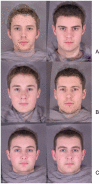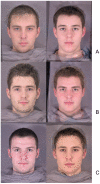Does masculinity matter? The contribution of masculine face shape to male attractiveness in humans
- PMID: 21048972
- PMCID: PMC2965103
- DOI: 10.1371/journal.pone.0013585
Does masculinity matter? The contribution of masculine face shape to male attractiveness in humans
Abstract
Background: In many animals, exaggerated sex-typical male traits are preferred by females, and may be a signal of both past and current disease resistance. The proposal that the same is true in humans--i.e., that masculine men are immunocompetent and attractive--underpins a large literature on facial masculinity preferences. Recently, theoretical models have suggested that current condition may be a better index of mate value than past immunocompetence. This is particularly likely in populations where pathogenic fluctuation is fast relative to host life history. As life history is slow in humans, there is reason to expect that, among humans, condition-dependent traits might contribute more to attractiveness than relatively stable traits such as masculinity. To date, however, there has been little rigorous assessment of whether, in the presence of variation in other cues, masculinity predicts attractiveness or not.
Methodology/principal findings: The relationship between masculinity and attractiveness was assessed in two samples of male faces. Most previous research has assessed masculinity either with subjective ratings or with simple anatomical measures. Here, we used geometric morphometric techniques to assess facial masculinity, generating a morphological masculinity measure based on a discriminant function that correctly classified >96% faces as male or female. When assessed using this measure, there was no relationship between morphological masculinity and rated attractiveness. In contrast, skin colour--a fluctuating, condition-dependent cue--was a significant predictor of attractiveness.
Conclusions/significance: These findings suggest that facial morphological masculinity may contribute less to men's attractiveness than previously assumed. Our results are consistent with the hypothesis that current condition is more relevant to male mate value than past disease resistance, and hence that temporally fluctuating traits (such as colour) contribute more to male attractiveness than stable cues of sexual dimorphism.
Conflict of interest statement
Figures


Similar articles
-
A new data-driven mathematical model dissociates attractiveness from sexual dimorphism of human faces.Sci Rep. 2020 Oct 6;10(1):16588. doi: 10.1038/s41598-020-73472-8. Sci Rep. 2020. PMID: 33024137 Free PMC article.
-
The masculinity paradox: facial masculinity and beardedness interact to determine women's ratings of men's facial attractiveness.J Evol Biol. 2016 Nov;29(11):2311-2320. doi: 10.1111/jeb.12958. Epub 2016 Aug 22. J Evol Biol. 2016. PMID: 27488414
-
Microbes and masculinity: Does exposure to pathogenic cues alter women's preferences for male facial masculinity and beardedness?PLoS One. 2017 Jun 8;12(6):e0178206. doi: 10.1371/journal.pone.0178206. eCollection 2017. PLoS One. 2017. PMID: 28594843 Free PMC article.
-
Self-rated Attractiveness and Sociosexual Behavior Predict Gay Men's Preferences for Masculine Cues in Male Voices in China.Evol Psychol. 2019 Apr-Jun;17(2):1474704919847430. doi: 10.1177/1474704919847430. Evol Psychol. 2019. PMID: 31068003 Free PMC article.
-
Do men's faces really signal heritable immunocompetence?Behav Ecol. 2013 May;24(3):579-589. doi: 10.1093/beheco/ars092. Epub 2012 Oct 24. Behav Ecol. 2013. PMID: 23555177 Free PMC article.
Cited by
-
Adiposity, compared with masculinity, serves as a more valid cue to immunocompetence in human mate choice.Proc Biol Sci. 2013 Jan 22;280(1751):20122495. doi: 10.1098/rspb.2012.2495. Proc Biol Sci. 2013. PMID: 23193134 Free PMC article.
-
Warriors and peacekeepers: testing a biosocial implicit leadership hypothesis of intergroup relations using masculine and feminine faces.PLoS One. 2012;7(1):e30399. doi: 10.1371/journal.pone.0030399. Epub 2012 Jan 20. PLoS One. 2012. PMID: 22276190 Free PMC article.
-
Birth size and morphological femininity in adult women.BMC Evol Biol. 2020 Aug 15;20(1):102. doi: 10.1186/s12862-020-01670-z. BMC Evol Biol. 2020. PMID: 32799803 Free PMC article.
-
A new data-driven mathematical model dissociates attractiveness from sexual dimorphism of human faces.Sci Rep. 2020 Oct 6;10(1):16588. doi: 10.1038/s41598-020-73472-8. Sci Rep. 2020. PMID: 33024137 Free PMC article.
-
Sexually Dimorphic Faciometrics in Black Racial Groups From Early Adulthood to Late Middle Age.Evol Psychol. 2018 Oct-Dec;16(4):1474704918811056. doi: 10.1177/1474704918811056. Evol Psychol. 2018. PMID: 30458649 Free PMC article.
References
-
- Ryan MJ, Keddyhector A. Directional Patterns of Female Mate Choice and the Role of Sensory Biases. American Naturalist. 1992;139:S4–S35.
-
- Zahavi A. Mate Selection - Selection for a Handicap. Journal of Theoretical Biology. 1975;53:205–214. - PubMed
-
- Hamilton WD, Zuk M. Heritable True Fitness and Bright Birds - a Role for Parasites. Science. 1982;218:384–387. - PubMed
-
- Folstad I, Karter AJ. Parasites, Bright Males, and the Immunocompetence Handicap. American Naturalist. 1992;139:603–622.
-
- Angele MK, Schwacha MG, Ayala A, Chaudry IH. Effect of gender and sex hormones on immune responses following shock. Shock. 2000;14:81–90. - PubMed
Publication types
MeSH terms
LinkOut - more resources
Full Text Sources
Research Materials
Miscellaneous

